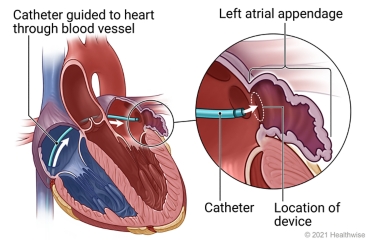
What is a left atrial appendage closure?
The left atrial appendage (LAA) is a small sac or pouch in the left atrium. The atrium is an upper chamber of the heart.
When you have atrial fibrillation (say "AY-tree-uhl fih-bruh-LAY-shun"), a type of irregular heartbeat, the heart's upper chambers quiver, or fibrillate. This can lead to blood clots in the left atrium. Most of these clots form in the LAA, where the blood pools. If a clot moves out of the heart and travels to the brain, it may cause a stroke.
A left atrial appendage closure is a procedure to close off the LAA. The procedure can help prevent a blood clot from moving out of the LAA. But it can't prevent a clot from forming in other areas of the left atrium.
Closing the LAA won't affect how your heart works. Your heart will still pump blood normally.
You may be asleep for the procedure, or you may get a sedative to help you relax. Your doctor makes a small cut in your groin. A thin flexible tube (catheter) with tools inside it is put inside your blood vessel and carefully guided to your heart. Your doctor moves the tip of the catheter to the LAA and places a small device inside it. The device expands and closes off the opening. It stays inside your heart. The catheter is then removed. In time, your heart will heal around the device. A layer of heart tissue will help seal off the LAA.
You may stay in the hospital for at least 1 night.
How do you prepare for the procedure?
Procedures can be stressful. This information will help you understand what you can expect. And it will help you safely prepare for your procedure.
 Preparing for the procedure
Preparing for the procedure
- Be sure you have someone to take you home. Anesthesia and pain medicine will make it unsafe for you to drive or get home on your own.
- Understand exactly what procedure is planned, along with the risks, benefits, and other options.
- Tell your doctor ALL the medicines, vitamins, supplements, and herbal remedies you take. Some may increase the risk of problems during your procedure. Your doctor will tell you if you should stop taking any of them before the procedure and how soon to do it.
- If you take a medicine that prevents blood clots, your doctor may tell you to stop taking it before your procedure. Or your doctor may tell you to keep taking it. (These medicines include aspirin and other blood thinners.) Make sure that you understand exactly what your doctor wants you to do.
- You may have a test before the procedure. This may be a CT scan.
- Make sure your doctor and the hospital have a copy of your advance directive. If you don't have one, you may want to prepare one. It lets others know your health care wishes. It's a good thing to have before any type of surgery or procedure.
What happens on the day of the procedure?
- Follow the instructions exactly about when to stop eating and drinking. If you don't, your procedure may be canceled. If your doctor told you to take your medicines on the day of the procedure, take them with only a sip of water.
- Follow your doctor's instructions about when to bathe or shower before your procedure. Do not apply lotions, perfumes, deodorants, or nail polish.
- Do not shave the surgical site yourself.
- Take off all jewelry and piercings. And take out contact lenses, if you wear them.
 At the hospital or surgery center
At the hospital or surgery center
- Bring a picture ID.
- You will be kept comfortable and safe by your anesthesia provider. The anesthesia may make you sleep. Or it may just numb the area being worked on.
- The procedure will take about 1 hour.
After the procedure
- Pressure may be applied to the area where the catheter was put in your blood vessel. This will help prevent bleeding. A small device may also be used to close the blood vessel. You may have a bandage or a compression device on the catheter site.
- Your care team will check your heart rate and blood pressure. They will also check the catheter site for bleeding.
- You will need to lie still and keep your leg straight for up to a few hours. A weighted bag may be put on your leg to help you keep it still.
- You may have a bruise or a small lump where the catheter was put in your blood vessel. This is normal and will go away.
Current as of: October 2, 2025
Author: Ignite Healthwise, LLC Staff
Clinical Review Board
All Ignite Healthwise, LLC education is reviewed by a team that includes physicians, nurses, advanced practitioners, registered dieticians, and other healthcare professionals.

